#francesco maestrelli
Text
RG MS Q3: Meet Your Qualifiers (Day 2)

The Roland Garros opening week atmosphere (📸 Roland Garros official website)
For a more compact version in the form of a Twitter thread, click here.
For the first part of the article, click here.
For the qualifiers' placement after the second part, which is also reflected starting this article, click here. Take the vague previews with a grain of salt.
The second day of the Roland Garros third qualifying round matches will feature the last 8 clashes, this time with the rest of the sections who finished toward the end of that day two days ago battling for a spot in the main draw. While some or most of the sections looked top-heavy or in-form heavy (1-2, 4-8, 16), this arrangement might have, once again, saved the best (and the most classic matches) for the last while notably emerging/resurging players also took the stage today, such as but not limited to J.J. Wolf, Thiago Monteiro, Zizou Bergs, Jozef Kovalik, and the latest Oeiras 4 Challenger titlist, Jaime Faria, among others.
With that, meet your qualifiers from the rest of the sections (featuring an oversimplified match report of each match as they qualified):
Section 2: Jesper de Jong def. J.J. Wolf [2] 6-1, 6-2
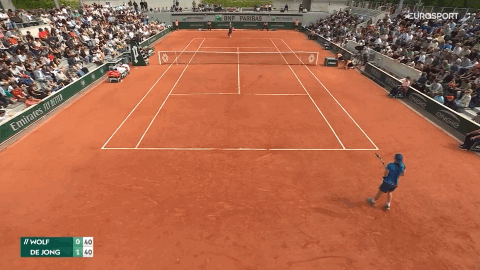
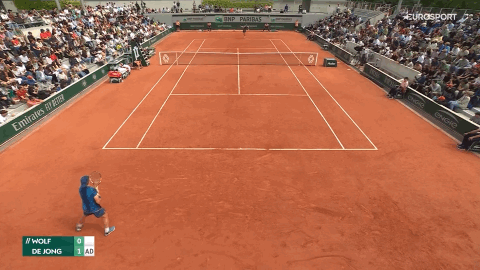

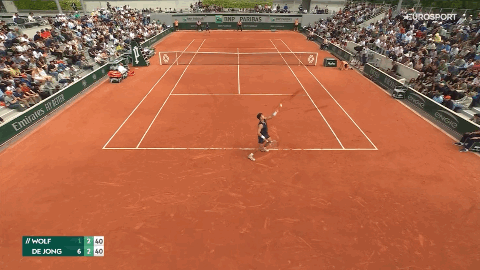
Jesper de Jong's point to 1-0* 40-ad, 1st set (top left), to break 2-0 in the 1st set (top right), to 1-1* 0-15, 2nd set (bottom left), and to *2-2 40-ad, 2nd set (bottom right) (📸 Eurosport GB)
J.J. Wolf might have an unideal start to the season, sustaining an injury in the first round of the Australian Open that resulted in him falling back in the rankings after being unable to defend his fourth-round achievement in 2023, which was followed by a disappointing green-clay campaign as he was defeated by Dmitry Popko and former junior World No. 3 Henry Searle in the first rounds of Sarasota and Tallahassee Challengers, respectively, followed by qualifying for the Turin Challenger main draw only to be defeated by Lorenzo Sonego 3-6, 3-6 in the first round. However, J.J. seemingly picked up where he left off as he battled Ryan Peniston 6-1, 6-7(5), 6-2, and Patrick Kypson 6-3, 6-3 in the first two qualifying rounds of Roland Garros. Almost similarly, despite qualifying for the Australian Open earlier this year, Jesper de Jong also had a similar rollercoaster, as he was unable to defend his Girona Challenger semifinal from last year after being eliminated by Lorenzo Giustino 5-7, 4-6 in the quarterfinals, followed by another quarterfinal achievement in Rome (Italy) Challenger a fortnight later (l. Alejandro Moro Canas). Despite this, he stayed competitive in most of his other runs, proving he was still here to qualify as he defeated another in-form player in Pablo Llamas Ruiz and Dennis Novak to set up this clash. Other than their offensives, this match could test their point construction, and at their best, it all could come down to how they executed their points.
After holding his service game to 1-0 in the first set, J. de Jong started to become more aggressive, forcing the deuce due to J.J.’s forehand error before a drop shot generated his break point, followed by a backhand down-the-line winner to break early (2-0). After a massive hold to 3-0, the Dutch took advantage of J.J.’s erratic service game before doubling the break 4-0, somehow boldening the lead with a service game hold to 5-0. As J. de Jong ended the set by serving a breadstick (6-1), his dominance continued by scoring a forehand pass one point into the third game even if J.J. held his service game to 2-2, which averted the bakery product at some point. However, as hard as J.J. tried to fumble the said break points, J. de Jong increased his offensive ballstriking, coming up with a forehand winner and a drop shot to secure his other 2 break points before it was ultimately converted due to his double fault (3-2). Somehow, increasing his aggression, J. de Jong trusted his forehand well to secure his one-point lead before a failed smash from J.J. secured the former’s 2-point lead, allowing him to double the break before J. de Jong secured another Grand Slam qualification for the year by taking the second set 6-2.
In the first round, J. de Jong will face Jack Draper, with a potential second-round match against Carlos Alcaraz or... a potential rematch of this one. Not an easy one, but considering J. Draper's level on clay, who knows.
Section 1: Filip Misolic def. Quentin Halys 2-6, 6-4, 6-3

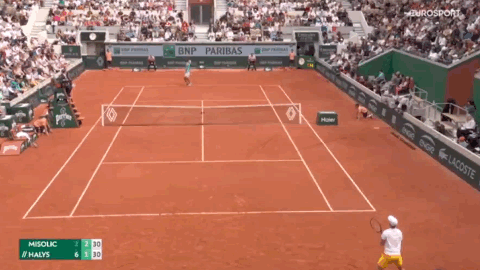
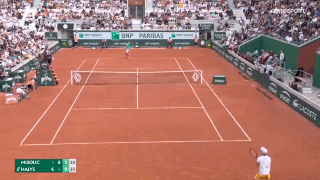
Filip Misolic's points to 2-2* 0-30, 1st set (top left), to 2-1* 30-40, 2nd set (top right), and to 1-0* 30-40, 3rd set (bottom) (📸 Eurosport GB)
Since his Salzburg Challenger first-round meeting against Dominic Thiem despite the loss and reaching the runner-up in Kitzbühel (250) to Roberto Bautista Agut in 2022, F. Misolic's season has been a rollercoaster, including the 6-12 win-lose record before entering the Roland Garros qualifying rounds, with his major result being the quarterfinalist of Split Challenger (l. Zsombor Piros). He somehow found his way to bounce back in the first two qualifying rounds in Roland Garros, as he defeated both Sho Shimabukuro and Ugo Blanchet (who stunned first seed Cristian Garin in the first qualifying round) both in straight sets (6-3, 6-2 and 6-4, 6-2, respectively). Interestingly, outside of his usual hard-court setting, Quentin Halys mostly exited early (despite qualifying for the main draw in the Aix-en-Provence Challenger only to lose 1-6, 2-6 vs. Botic van de Zandschulp) while trying to regain his form, which he might likely rediscover in the Roland Garros qualifying rounds, defeating Alexis Galarneau 7-5, 6-3 and 29th seed Diego Schwartzman 4-6, 6-4, 7-6(7) in a 3-hour-5-minute thriller. This match might also bring the best out of them, with the more offensive player in general taking this match, and it turned out to deliver just that.
F. Misolic might have suffered from a nervy start as he got broken early to 1-0 in the first set, but he steadily tried to trust his forehands, which helped him to generate break points in the fourth game only for Halys to hold to 3-1, where the Frenchman ended up dominating the set by taking it 6-2. However, F. Misolic tried to absorb some pace, where his intuitive volley turned out to create his break point before his forehands once again were trustable enough to secure him the early break to 2-1 to start the second set. Despite being broken back to 4-3, F. Misolic hung in there to hold several games before capitalizing on Halys’ errors to break for the second set (6-4), mostly due to Halys’ forehand errors and a double fault in between. The Austrian carried through the third set, breaking to 2-0 after a lengthy game thanks to his slice pass that created his break point, but Halys’ forehand rushes afterward also did not help. F. Misolic almost broke for the match thanks to his forehand pass to 5-2* 40-ad, but still successfully served for the match to 6-3 as he had to do so.
In the first round, F. Misolic will face Christopher O'Connell. C. O'Connell could be something else on clay, but there is a slight chance that the former will make it as long as he is stable enough with his groundstrokes. Maybe.
Section 5: Roman Andres Burruchaga def. Jozef Kovalik 4-6, 7-6(2), 6-4
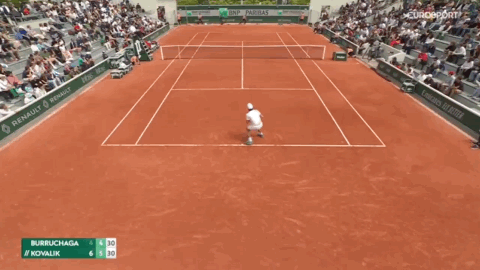
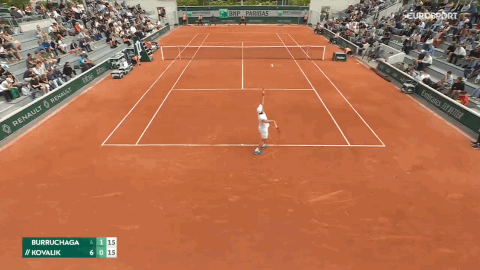

Roman Andres Burruchaga's points to 1-1* 15-30, 2nd set (top left), to *5-4 30-40, 2nd set (top right), and to *3-1 40-15, 3rd set (bottom) (📸 Eurosport GB)
While on paper, some might not expect this section to come down to this encounter, the son of a legendary football player, Jorge Burruchaga, Roman Andres Burruchaga, solidly built his form in his way, most notably defeating Diego Schwartzman 6-1, 4-6, 6-4 in the first round of Cordoba (250), followed by a semifinal showing in Asuncion (l. Joao Fonseca 6-7(5), 6-1, 3-6) and Florianopolis Challengers (l. Enzo Couacaud 2-6, 1-6) before embarking in his European Challengers campaign with a second-round loss to Gerald Melzer, but achieved a semifinal finish in Oeiras 4 Challenger against Jaime Faria 4-6, 7-6(5), 1-6 in another thrilling battle. Not a far stretch, this led him being able to defeat fifth seed Juncheng (Jerry) Shang 6-4, 7-6(5) despite the latter’s likely illness, and Yasutaka Uchiyama 6-2, 6-4 in the first two qualifying rounds. Interestingly, J. Kovalik is also currently in-form, as he was close to winning the Croatian treble since he won the Zadar (d. Adrian Andreev 6-4, 6-2) and Split Challengers (d. Zsombor Piros 6-4, 5-7, 7-5) before becoming the runner-up to a resurgent Lucas Pouille in the Mauthausen Challenger (3-6, 3-6) a fortnight before the Roland Garros qualifying rounds, where he confidently defeated two French veterans in straight sets (Benoit Paire 6-1, 6-4 and Benjamin Bonzi 6-3, 6-2) in the first two qualifying rounds. It could be all to play for in this match, striking the ball as smoothly and accurately as possible to stand out.
This match turned out to be topsy-turvy as their consistency was also tested throughout this match. J. Kovalik initially broke early (1-0 in the 1st set) before consolidating his position, but Roman started to trust his strokes as he scored a backhand pass to hold his serves to 4-1, finally putting his name on the board. Interestingly, a swift return at *5-2 15-30 brought the Argentinean back to the match, breaking to 5-3 even if J. Kovalik took the 1st set 6-4. The Slovak was also up a break in the second set (3-2) due to Roman’s forehand error, but the latter bounced back as he found his groundstrokes, smashing his way to create his break point to *5-4 30-40 before breaking back to 5-5. This then changed the trajectory of the match, as Roman dominated the tie-breaker from the baseline to take the second set 7-6(2) to force the deciding set, where once again, J. Kovalik led by an early break to 3-1 in its beginning thanks to his point construction. It was not over yet for Roman, who fought back thanks to his drop shot to generate his break point before breaking back to 3-2, leveling the play with a service game hold to 3-3. Somehow, Roman did not look back as he still went after J. Kovalik’s forehand errors, which resulted in the former’s break of serve (4-3) and he consolidated it to 5-3. Ultimately, Roman took the third set 6-4, showing his grit to close the match and secure his maiden Grand Slam-level main draw appearance.
In the first round, Roman will face Jan-Lennard Struff, with the winner possibly facing 19th seed Alexander Bublik in the second round. This could be a good test of the former’s depth and aggression, but Struffi is no easy feat when the balance of power is right.
Section 16: Felipe Meligeni R. Alves [23] def. Jaime Faria 6-4, 6-2
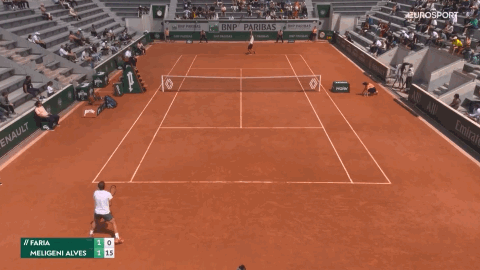
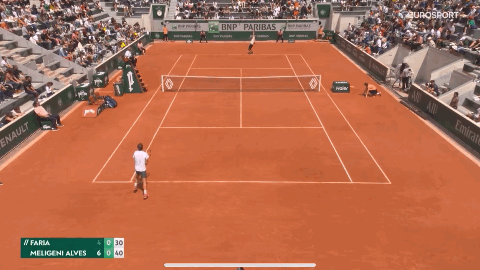

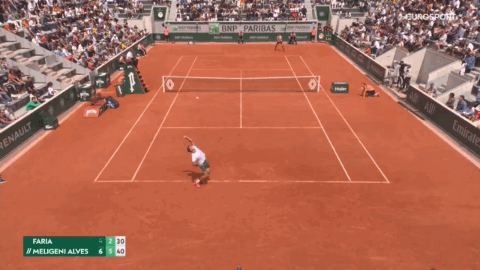
Felipe Meligeni R. Alves' points to *1-1 0-30, 1st set (top left), to *1-1 0-30, 2nd set (top right), to 4-2* 15-15, 2nd set (bottom left), and to take the second set 6-2 (bottom right) (📸 Eurosport GB)
J. Faria had a confident start to the clay season as he qualified for the Estoril (250) as a qualifying wild card by defeating Mate Valkusz and Lukas Klein before bowing out to eventual quarterfinalist David Jorda Sanchis 6-7(4), 1-6 in the first round, followed by a stellar showing in the Oeiras 3 Challenger as a semifinalist despite being comebacked by eventual champion Francisco Comesana 5-7, 7-6(4), 6-0 as he got broken back when he had a one-break advantage in the second set. Despite several earlier exits afterward in the Ostrava Challenger quarterfinals and Prague 2 Challenger second round, J. Faria went on to win his maiden Challenger title in Oeiras 4 (d. Elias Ymer 3-6, 7-6(3), 6-4 to complete his last three-rounds thriller), and continued this form as he defeated Clement Tabur and Zachary Svajda in straight sets, even though he was 1-4 down in the first set for the latter match. Another possibly compelling story came from Felipe, where he reached the semifinals of the Sao Leopoldo Challenger (l. Adolfo Daniel Vallejo) and battled Valentin Vacherot in the second round of the Aix-en-Provence Challenger despite the loss (3-6, 6-3, 6-7(4)), continuing through the quarterfinals of the Turin Challenger where he was defeated by Lorenzo Musetti 1-6, 3-6 after the previous three-set thrillers against Thiago Agustin Tirante and Francesco Maestrelli. Just like J. Faria, Felipe had a strong qualifying campaign here in Roland Garros as he defeated Nerman Fatic and Zdenek Kolar in straight sets, setting up arguably the match of the day (and round) between two in-form players, which, at their best, could be a classic with various twists and turns depending on their balance of power and groundstrokes to stand out in this match.
Initially, J. Faria held his service game to 1-0 to start the first set, but he was unable to capitalize on his 2 break points that were made due to Felipe’s forehand rushes, where the latter turned out to hold his serves to 1-1. It became a crucial hold as Felipe smashed his way to generate his 2-point lead, where he turned out to break to 2-1 as a result of J. Faria’s unforced errors. He then consolidated the lead to 3-1, and despite facing stiff opposition in J. Faria’s aggression, Felipe stood his ground to take the first set 6-4. Somehow, Felipe carried this fine form by breaking early to 1-0 thanks to his forehands, and he had not looked back since. He froze as he fired a successful cross-court forehand lob, where J. Faria asked for a mark-check and it turned out to be in, securing the Brazilian’s equalizer to 4-2* 15-15 before his break doubled due to J. Faria’s double fault. As a result, the 23rd seed earned an opportunity to serve for the match, where his forehand winner perfectly closed it to take the second set 6-2, securing his spot in another Grand Slam-level main draw after last year’s heartbreak of being comebacked.
In the first round, Felipe will face seventh seed Casper Ruud, which turned out to be their first meeting. At their best, this could be a competitive showing boiling down to their shot execution, and while the latter had the slight edge in terms of experience, this clay season could give us anything.
Section 7: Mikhail Kukushkin [25] def. Francesco Maestrelli 6-4, 6-7(4), 6-2

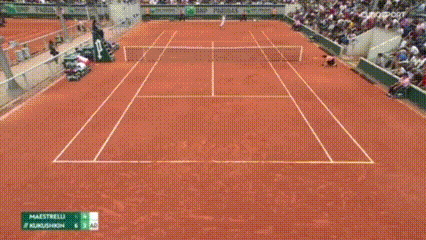

Mikhail Kukushkin's points to *1-1 15-30, 2nd set (top left), to hold 4-4, 2nd set (top right), and to break 5-3, 3rd set (bottom) (📸 Eurosport GB)
While some might not expect this section to come down to this either, both players made their cases en route and during the Roland Garros qualifying rounds. F. Maestrelli built his form starting the semifinal appearance in the Szekesfehervar Challenger (l. Chun-Hsin Tseng), followed by 2 quarterfinal exits in Barletta (l. Damir Dzumhur) and Rome (Italy) (l. Stefano Napolitano) to precede 2 other early exits, followed by another competitive loss against Felipe Meligeni R. Alves 3-6, 6-4, 6-7(4) in the Turin Challenger quarterfinals. In Roland Garros, he battled Marc-Andrea Huesler 6-7(2), 6-2, 6-4 before advancing due to Bernabe Zapata Miralles’ retirement down 1-6 upon the conclusion of the first set in the first two qualifying rounds. On the other hand, 25th seed and former World No. 39 Mikhail Kukushkin resurged back in the hard courts after winning the Manama Challenger title, as well as the Tenerife 3 Challenger title due to Matteo Gigante’s retirement down 2-6, 0-2 in the finals as a qualifier. Despite he often unable to catch a break after some battles, as evident in the Madrid Challenger semifinal when he had to retire down 2-6, 1-4 against eventual champion Stefano Napolitano, he was still able to battle it out when he was ready despite some early exits in Aix-en-Provence Challenger first round (as a qualifier) and the second round of Rome Masters 1000 (l. Diego Schwartzman), both in 3 sets for his most recent records. Interestingly, he won straightforwardly in the Roland Garros qualifying rounds, using his experience to defeat Leandro Riedi 6-4, 6-3 and Li Tu 6-4, 6-2 in the first two rounds. Knowing both players, while this could be both tricky and physical, this match possibly tested their aggression, anticipating the ball as early as possible to stand out in this match.
This match turned out to be a classic that Challenger-level watchers often enjoy. F. Maestrelli had a nervy start as his forehand errors only led to M. Kukushkin breaking early to 1-0, but the Kazakh’s forehand winner generated his break point before he doubled the break (3-0) only to be broken back due to his forehand errors. However, M. Kukushkin still managed to take the first set 6-4, continuing with a drop shot 3 points into the third game (of the second set) before breaking to 2-1. Two games later, F. Maestrelli increased his intensity, breaking back to 3-3 after he got even more aggressive, and M. Kukushkin had a massive hold thanks to winning the 36-shot rally even if he survived a break point to 4-4. He kept passing F. Maestrelli at times, continuing by his masterpieces after masterpieces of point construction in the 12th game to force the tie-breaker, but F. Maestrelli went after his forehands to dominate the tie-break, taking the second set 7-6(4) to force a deciding set. It took several moments before M. Kukushkin once again saved a break point in the sixth game (3-2), and his fight paid off as he secured a break point thanks to his forehand pass to 4-3* 15-40 after a forehand return ace. Afterward, he broke to 5-3 and successfully served for the match (6-3), securing his first Grand Slam appearance since the Wimbledon 2022 and Roland Garros appearance in 3 years (since 2021), the latter where his best result was only the 2nd round in 2011-12, 2014, 2017, and 2020.
In the first round, M. Kukushkin will face Fabian Marozsan. Recognizing the latter’s form and point construction abilities, this match could be tricky, but execution could also play a part. At their best, this could be a thriller, depending on the former’s fitness (hoping he is healthy enough to turn back the clock again).
Section 6: Thiago Monteiro [6] def. Daniel Rincon 6-4, 6-2
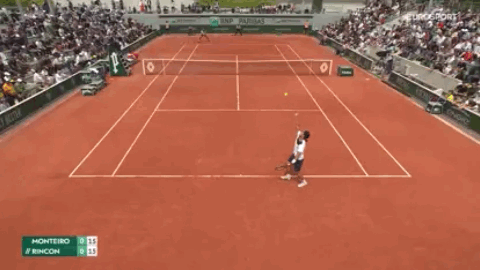
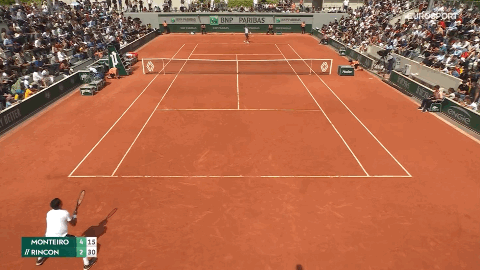

Thiago Monteiro's points to *0-0 15-30, 1st set (top left), to 4-2* 30-30, 1st set (top right), and to 2-2* 0-15, 2nd set (bottom) (📸 Eurosport GB)
T. Monteiro might have had a disastrous end-of-season by having to retire down 4-6, 3-4 against Facundo Diaz Acosta back in Montevideo Challenger last year due to a wrist injury to add salt to the wound, taking into account his topsy-turvy second-half of last season, where he officially started his season in Punta del Este Challenger instead with a quarterfinal loss to Roman Andres Burruchaga. He began to rebuild steadily by reaching the semifinals of the Santa Cruz Challenger without dropping a set, except when he lost to Camilo Ugo Carabelli 4-6, 5-7 in the mentioned round. While it looked like the end of the tunnel back in the Oeiras 3 Challenger as he lost to Jaime Faria 2-6, 6-3, 6-7(2), he resurged in his subsequent tournaments as a qualifier by reaching the third round of the Madrid Masters 1000 after stunning former World No. 3 Stefanos Tsitsipas 6-4, 6-4 despite the loss to Jiri Lehecka 4-6, 6-7(7) afterward, and reaching the fourth round of the Rome Masters 1000 before bowing out to Zhizhen Zhang 6-7(4), 3-6, continuing this trail as he defeated Murkel Dellien 6-4, 6-1 and Valentin Royer 3-6, 6-3, 6-4 in the first two qualifying rounds of Roland Garros. On the other hand, D. Rincon also balanced his Challenger and ITF appearances to secure his spot in the Roland Garros qualifying rounds as he tried to regain his form, as he notably eliminated in the second round of the Ostrava Challenger (l. Timofey Skatov) and became a semifinalist in ITF M25 Sabadell (Apr 29) as he was defeated by Nikolas Sanchez Izquierdo 4-6, 0-6. Starting his Roland Garros qualifying campaigns, he turned out to emerge victorious after two 3-set matches in his first two qualifying round matches against 24th seed Jurij Rodionov 2-6, 7-5, 6-2 and Aziz Dougaz 6-7(6), 6-2, 6-2, setting up this intriguing clash for the third qualifying round. This encounter could also be saved for the last, testing their aggression and their pressure points handling at their best since the margin could have looked thin within both players, which made this match exciting to watch.
In contrast, this match went straightforward instead as soon as T. Monteiro clicked his forehand, found his aggression, and maintained his range well. Just in the first game, T. Monteiro scored a fourth-shot forehand winner before generating his break point similarly, outhitting D. Rincon’s forehand side to break early (1-0). D. Rincon had his fair chances midway as the second game turned out to be an out-passing contest, but T. Monteiro managed to consolidate his lead to 2-0, and he almost doubled the break thanks to his forehand before the Spaniard held to 4-3. The Brazilian sixth seed then took the first set 6-4, and he dominated the flow since, disguising his drop shot as if he was about to hit a volley at the first point of the fifth game (in the second set) before he broke to 3-2, holding his service game right after (4-2). Subsequently, through a forehand pass to D. Rincon’s volley error, T. Monteiro doubled the break to 5-2, serving it out (6-2) to complete the assignment and advance to the main draw.
In the first round, T. Monteiro will face Miomir Kecmanovic. It will be their third Tour-level meeting (fourth overall) as both players shared a meeting apiece on the main Tour. Somehow, this will be a rematch of their Rome Masters 1000 third-round encounter, where T. Monteiro won 6-2, 4-6, 7-6(6). Another potential tight contest underway, but M. Kecmanovic might need to step up his aggression a little under pressure to get out of more trouble.
Section 9: Henri Squire def. Andrea Vavassori 6-3, 3-6, 6-4




Henri Squire's point to 3-3* 40-ad (earlier break point, 1st set, top left), to 1-1* 0-30, 3rd set (top right), to 4-3* ad-40 (latest game point, 3rd set, bottom left), and to 5-4* 40-ad (latest match point, 3rd set, bottom right) (📸 Eurosport GB)
While he has a stellar doubles career with a runner-up in the Australian Open and has 3 Masters 1000 semifinals to his name (Indian Wells, Madrid, and Rome), A. Vavassori still tried to make it out in singles, beginning his clay season in the Buenos Aires (250) as he qualified for the main draw despite the loss against Carlos Alcaraz 6-7(1), 1-6 in the second round. Despite his rollercoaster singles showing on clay, his best result turned out to be the Barcelona (500) second round against Roberto Bautista Agut, where he lost 6-4, 3-6, 1-6. Through his patience, he battled it out in the first two qualifying rounds of Roland Garros by defeating fourth seed Albert Ramos Vinolas 6-3, 4-6, 6-3, and Benjamin Hassan 6-7(5), 7-6(2), 6-0 to advance to the third qualifying round. Here, he set up a clash with Henri Squire, who started his clay season by reaching the quarterfinal of the Split Challenger (l. Benjamin Bonzi) and notably became a runner-up to Damir Dzumhur in the Ostrava Challenger after being unable to serve it out from 5-1 in the third set that Dzumhur made a comeback win to 6-2, 4-6, 7-5 for the title. Continuing his clay season with some early exits in Prague 2 (l. Leandro Riedi) and Bordeaux Challengers (l. Matteo Martineau), H. Squire turned out to assert his revenge on Dzumhur in his first qualifying round win in Roland Garros 2-6, 6-3, 6-4 before confidently defeating Hugo Grenier 6-2, 6-4 in the subsequent round. Realizing both players’ point construction prowess, this match, at its best, could turn out to depend on their execution of these points, which determined the rest of the flow as well.
It took six consecutive holds for H. Squire to finally come up with something, this time with a working volley for his one-point lead before holding his serves to 4-3 in the first set. Suddenly, taking advantage of A. Vavassori’s preceding errors, the German had several break points, one of which was created thanks to a drop shot (and another one with his preceding backhand, followed by his drop shot) before breaking to 5-3, where he went on to take the first set 6-3. Even if H. Squire was up a break to 2-1 as a result of A. Vavassori’s unforced errors, the Italian went back into the match thanks to his backhand pass before he held to 4-3, somehow breaking for the match due to H. Squire’s forehand errors, topped by a double fault before returning the favor and took the second set 6-3. As a result, they went to the deciding set, where it looked like A. Vavassori was about to complete his comeback by breaking to 2-1, but H. Squire capitalized on the former’s error spree to break back 4-4, bravely saving his break points until hitting the drop shot and lob combination for his latest game point before a crucial hold to 5-4. Since then, the German tried to utilize his point construction in his favor while bringing A. Vavassori off-balance, generating his latest match point through a double drop shot that ended with a forehand pass before breaking for the match (6-4) to secure his first-ever Grand Slam main draw showing.
In the first round, H. Squire will face Max Purcell. The Australian had a rough patch lately in singles, with some notable early exits even in the Asian hard-court Challengers as he tried to maintain his Top 100 ranking. There might be a slight chance for the former on condition that he keeps his point construction stable enough to overwhelm the latter.
Section 8: Zizou Bergs def. Mathias Bourgue 6-2, 7-6(4)

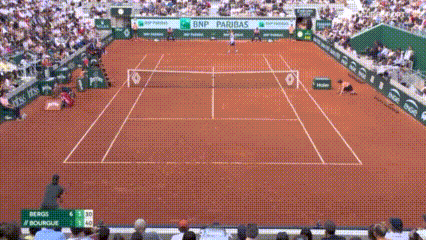
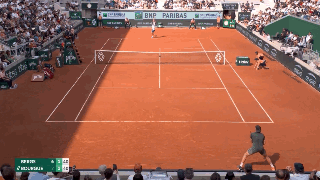
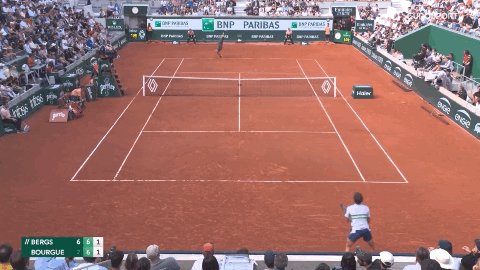
Zizou Bergs' points to 5-1* 40-40, 1st set (top left), to 1-1* 40-40, 2nd set (top right) and to 1-1* 40-ad, 2nd set (bottom left), and to 6-6(2-1, 2nd set tie-break) (bottom right) (📸 Eurosport GB)
Z. Bergs came into the Roland Garros qualifying rounds on fire, as he confidently started the green clay season with a runner-up finish in the Sarasota Challenger (l. Thanasi Kokkinakis) and successfully defended his title in the Tallahassee Challenger (d. Mitchell Krueger) before being rewarded with the Madrid Masters 1000 wild card, where he was defeated by Luca van Assche 6-4, 6-7(0), 6-1. He then confirmed his Top 100 ascension by qualifying for the Rome Masters 1000, defeating both Patrick Kypson (4-6, 6-3, 6-4) and Juncheng (Jerry) Shang (6-4, 7-6(5)) before facing former World No. 1 Rafael Nadal in the first round, which he took a set from in the first set before the 6-4, 3-6, 4-6 loss. Right afterward, he went straight to the Roland Garros qualifying rounds as he defeated wild card Clement Chidekh 6-1, 6-1 and Joris de Loore 6-4, 2-6, 6-4, the latter in an all-Belgian classic clash. Z. Bergs then faced a resurging wild card in former World No. 140 Mathias Bourgue, where he juggled between the Challengers and ITFs to stay on track, to no avail, with most ending in early exits, with his significant result being a second-round loss to Radu Albot 6-7(5), 6-2, 4-6 in the Murcia Challenger, and notably defeated Duje Ajdukovic 6-3, 6-4 in the first qualifying round of the Bordeaux Challenger before being defeated by Quentin Halys 4-6, 4-6 then. The Frenchman then suddenly rediscovered his form in 3-set victories against wild card (even 10 years younger and currently emerging) Mae Malige 4-6, 6-2, 6-2 before stunning 26th seed Radu Albot 1-6, 6-4, 6-4 in the second qualifying round. Knowing Z. Bergs’ form, this match-up could probably be tough for M. Bourgue to match in terms of pace (and power) on paper, but anything could still be possible if the latter dug deeper than his first two matches in this tournament.
Z. Bergs had a dominant start to the match as he broke early to 1-0 in the first set, where he consolidated his lead to 2-0 and even doubled the break thanks to his drop volley to M. Bourgue’s forehand error (4-1). He almost baked the first-set breadstick after forcing the deuce thanks to his functional lob, but he settled by taking the set 6-2 as M. Bourgue held the previous game. The Belgian’s point construction suddenly peaked thanks to his intuitive forehand pass to force a deuce in the third game of the second set before he created his break point through his drop shot, ultimately breaking to 2-1 only to be broken back to 2-2. Somehow, the eighth seed broke back again thanks to his forehand down-the-line winner (3-2) and had not looked back since, but he had to overcome tightness as M. Bourgue increased his level with an insane crowd backing, where he was unable to serve for the match twice (at *5-4 and *6-5) as he tried to regain his range every time. The second tie-breaker then happened, where Z. Bergs’ pass secured his lead to 2-1 before M. Bourgue’s double-fault confirmed the former’s mini-break (3-1), and even if he had a match point saved due to his +1 forehand rush (6-4), an unreturned serve cleaned up his act to take the second set 7-6(4), as well as sealing the last qualifier spot of the tournament to conclude the opening week.
In the first round, Z. Bergs will face 24th seed Alejandro Tabilo, who reached a new height of his career after winning the Aix-en-Provence Challenger and becoming a semifinalist of the Rome Masters 1000. This could be a 5-set tussle at their best, emphasizing the execution of their shots along the way. Perhaps a highlight-reel-inducing match as well!
The lucky losers will be featured in the subsequent article.
#atp world tour#atp tour#grand slam#french open#roland garros#roland garros 2024#tennis updates#hot shots#break point#match point#jesper de jong#j.j. wolf#filip misolic#quentin halys#roman andres burruchaga#jozef kovalik#felipe meligeni alves#jaime faria#mikhail kukushkin#francesco maestrelli#thiago monteiro#daniel rincon#henri squire#andrea vavassori#zizou bergs#mathias bourgue#know your qualifiers
0 notes
Text
youtube
0 notes
Text
Izida Cup 2024 (Dobrich, Bulgaria)

Canadians Liam Draxl and Cleeve Harper won yesterday the title at the ATP Challenger 50 in Dobrich, Bulgaria thanks to a 6-1, 3-6, [12-10] victory over Italians Francesco Maestrelli and Filippo Romano. This is Draxl's third ATP Challenger doubles title (also won in Lexington in 2021 and Little Rock earlier this year) and Harper's first.
(Picture : © IONIK Vêtements Sport)
0 notes
Video
youtube
Matteo Gigante vs Francesco Maestrelli | SF Tenerife • Highlights
0 notes
Text
Tennis: qualificazioni Australian Open, derby Nardi-Maestrelli
Sono 18 i tennisti italiani ai nastri
di partenza delle qualificazioni degli Australian Open che
scattano domani sui campi in cemento di Melbourne Park (domenica
14 il via ai main draw). Si incontreranno per la prima volta in
carriera Luca Nardi, numero 118 del mondo e testa di serie
numerio 13, e Francesco Maestrelli (223). Altri due italiani
figurano tra le teste di serie del tabellone di…
View On WordPress
0 notes
Text
Ramkumar Ramanathan Through to Doubles Quarterfinals
Last Updated: February 22, 2023, 22:12 IST
Indian tennis star Ramkumar Ramanathan (Twitter)
Ramanathan along with his Italian partner Francesco Maestrelli recorded a 6-2, 7-6 (4) win over Colin Sinclair of North Mariana Islands and Miljan Zekic of Serbia at the KSLTA courts
India’s Ramkumar Ramanathan along with his Italian partner Francesco Maestrelli stormed into the doubles quarter-finals…

View On WordPress
0 notes
Photo

http://www.corrieredellosport.it
Alessandro Nesta: un cuore diviso a metà
a mattina del 31 agosto 2002, Alessandro Nesta era ancora in campo a Formello, con la maglia biancoceleste addosso. I tifosi erano convinti che il pericolo di perderlo fosse scongiurato. La Lazio, sebbene fossero passati soltanto due anni dallo scudetto, non se la passava bene dal punto di vista economico: aveva bisogno di risanare, e per risanare c’era bisogno di cedere. Nesta, a quei tempi, era il massimo che una grande squadra potesse desiderare nel ruolo di difensore centrale.
Ma i laziali non volevano rassegnarsi: anche nell’ultimo giorno di mercato, implorarono il loro idolo di non lasciare la Capitale. Niente da fare: «La cessione del nostro capitano Alessandro Nesta (per 31 milioni di euro, ndr) è un grande sacrificio effettuato per agevolare il riequilibrio finanziario in corso della società e per garantire alla squadra la necessaria tranquillità per nuove stagioni di successi sempre nell’élite del calcio mondiale - disse l’allora presidente della Lazio, Sergio Cragnotti -. Un grazie di cuore per tutto quello che ha fatto e dato alla Lazio in questi 18 anni in maglia biancoceleste. Lui sa che il sacrificio della sua cessione ha soltanto queste giustificazioni di risanamento della società e io lo ringrazio, a nome di tutti i laziali, per la disponibilità dimostrata. Alessandro Nesta resterà per sempre nel patrimonio della tifoseria biancoceleste». Una storia d’amore, quella di Nesta con la Lazio, iniziata nel 1985, quando aveva soltanto nove anni: i derby contro Francesco Totti, lo scudetto Primavera vinto nel 1995, quando Dino Zoff lo aveva già promosso tra i grandi.
Ci mise pochissimo, Nesta, a diventare il simbolo della Lazio: orgoglio romano di una squadra che con un allenatore svedese - Sven Goran Eriksson - e tanti giocatori arrivati dall’estero si stava affacciando anche al grande calcio internazionale. Nel 1998, vinse la Coppa Italia e perse la finale di Coppa Uefa, ma quello fu anche l’anno del grave infortunio al ginocchio durante il Mondiale di Francia. La Lazio si avvicinò allo scudetto nel 1999: lo perse, ma seppe consolarsi con la vittoria della Coppa delle Coppe e, pochi mesi dopo, della Supercoppa Europea contro il Manchester United, prologo di una stagione storica conclusa con il tricolore conquistato a distanza di 26 anni da quello della Lazio di Maestrelli.
ALESSANDRO NESTA AL MILAN - Complessivamente, nella sua carriera, Nesta ha vinto altri due scudetti con la maglia del Milan: il primo nel 2004, il secondo nel 2011. Ma quelli rossoneri sono stati anche gli anni di altri trofei internazionali, sia con il club che con la Nazionale: Nesta, alla prima stagione a Milano, ha subito centrato l’obiettivo della Champions League, in finale a Manchester contro la Juventus, segnando anche uno dei rigori della serie. La seconda Champions sarebbe arrivata nel 2007, un anno dopo il titolo mondiale, a parziale rivincita di quello che era accaduto nel 2005 a Istanbul, con il Milan avanti di tre gol sul Liverpool ma rimontato e battuto ai calci di rigore.
A 35 anni, Nesta rinnovò il suo contratto con il Milan fino al 2012: il tempo di vincere un’altra Supercoppa Italiana, a Pechino contro l’Inter. Nei dieci anni in rossonero, 326 partite e 10 gol, con due scudetti, una Coppa Italia, due Supercoppe italiane, due Champions League, due Supercoppe Europee e un Mondiale per Club. Abbastanza per lasciare l’Italia da eroe e concedersi un’esperienza in Canada, prima di dire basta con il calcio giocato.
1 note
·
View note
Text
...Inseguendo il Tennis, Francesco Maestrelli.
…Inseguendo il Tennis, Francesco Maestrelli.
Chi è Francesco Maestrelli? Un nostro concittadino che ha giocato gli Open degli Stati Uniti. Si avete letto bene, ha giocato!
Perché a vedere il torneo più famoso e ricco al mondo, dalla città di Galileo Galilei, ci sono andati in molti ma a giocarlo non c’era ancora riuscito nessuno. Nel 2022 il popolo pisano ha raggiunto anche questo obiettivo, e che obiettivo.
Francesco è alto un metro e…

View On WordPress
0 notes
Text
Co się dzisiaj działo? #68 9.3.2022
Krykiet, mecz testowy, dzień 2
Indie Zachodnie (202/4, Kraigg Brathwaite 55, Jayden Seales 4/79)-Anglia (311, Jonny Bairstow 140, Ben Stokes 1/20)
ICC Puchar Świata Kobiet: Indie Zachodnie (225/6, Shemaine Campbelle 66, Shamilia Connell 3/38) pokonały Anglię (218, Tammy Beaumont 46, Sophie Ecclestone 3/20) 7 runami
ICC Cricket World League 2: Oman (221/7, Khawar Ali 63, Fayyaz Butt 3/28) pokonał ZEA (213, Chirag Suri 63, Zahoor Khan 4/51) 8 runami
NHL: Penguins-Panthers 3:4
Turniej ITF w Bendigo:
Weronika Falkowska-Rutuja Bhosale 0:6 2:6
Weronika Falkowska/Alexandra Bozovic-Jelena Micic/Leann Serna 6:1 6:4
CONCACAF Liga Mistrzów:
New York City-Comunicaciones 3:1
Seattle Sounders-Leon 3:0
Turniej ITF w Bhopal: Maks Kaśnikowski-Manish Sureshkumar 4:6 6:3 1:6
Maks Kaśnikowski/Alexis Canter-Prajwal Dev/Niki Kaliyanda Poonacha 5:7 5:7
Challenger w Roseto Degli Abruzzi:
Karol Drzewiecki/Jevvan Nedunchezhiyan-Andrej Martin/Tristan Samuel Weissborn 3:6 6:7(6)
Jan Zieliński/Hugo Nys-Francesco Maestrelli/Gabriele Piraino 6:2 7:5
Paryż-Nicea, 4 etap:
133. Łukasz Wiśniowski (119 w generalce)
Tirreno-Adriatico, 3 etap:
82. Rafał Majka (95 w generalce)
94. Maciej Bodnar (25 w generalce)
150. Cesare Benedetti (149 w generalce)
Turniej ITF w Creteil: Michał Mikuła-Nam Hoang Ly 6:7(4) 6:7(3)
Puchar świata w narciarstwie alpejskim, slalom w Flachau
Michał Jasiczek nie ukończył 1 przejazdu
Suzuki 1 Liga: Sokół Łańcut-Kociewskie Diabły 93:62
FIBA Europe Cup: Legia Warszawa-Reggiana 68:71
UEFA Europa League:
Betis-Eintracht 1:2
FC Porto-Olypmique Lyon 0:1
ULEB Eurocup: Śląsk Wrocław-Trento 77:68
EHF Liga Mistrzów: Vive Kielce-Dinamo Bukareszt 34:29
Alpe Adria Cup, ćwierćfinał: MKS Dąbrowa Górnicza-Zepter Wiedeń 91:88 (167:171 w dwumeczu)
UEFA Liga Mistrzów:
City-Sporting CP 0:0 (5:0 w dwumeczu)
Real Madryt-PSG 3:1 (3:2 w dwumeczu)
Puchar Polski w futsalu: AZS UG Gdańsk-Constract Lubawa 6:7
Campionato Sammarinese:
Cosmos-San Giovanni 0:0
La Fiorita-Faetano 0:0
Libertas-Fiorentino 1:3
Murata-Pennarossa 0:0
Tre Fiori-Cailungo 0:0
NCAA: Rhode Island Rams-Duquesne Dukes 79:77
Igrzyska Paraolimpijskie w Pekinie, dzień 5
paranarciarstwo klasyczne, sprinty
mężczyzn siedząc
1. Zheng Peng (CHN)
2. Mao Zhongwu (CHN)
3. Collin Cameron (CAN)
23. Krzysztof Plewa
kobiet siedząc
1. Yang Hongqiong (CHN)
2. Oksana Masters (USA)
3. Li Panpan (CHN)
13. Monika Kukla
mężczyzn stojąc
1. Benjamin Daviet (FRA)
2. Marco Maier (GER)
3. Grygorii Vovchynskyi (UKR)
17. Witold Skupień
kobiet stojąc
1. Natalie Wilkie (CAN)
2. Vilde Nilsen (NOR)
3. Sydney Peterson (USA)
9. Iweta Faron
mężczyzn z przewodnikiem
1. Brian McKeever/(p)Russell Kennedy (CAN)
2. Jake Adicoff/(p)Sam Wood (USA)
3. Zebastian Modin/(p)Emil Jonsson (SWE)
7. Piotr Garbowski/(p)Jakub Twardowski
15. Paweł Gil/(p)Michał Lańda
Paweł Nowicki/(p) Jan Kobryń nie ukończyli kwalifikacji
kobiet z przewodnikiem
1. Carina Edlinger/(p)Josef Lorenz (AUT)
2. Oksana Shyshkova/(p)Andryi Marchenko (UKR)
3. Linn Kazmaier/(p)Florian Baumann (GER)
9. Anna Górska/(p)Catherine Spierenburg
parahokej:
Korea Południowa-Wlochy 4:0
Chiny-Czechy 4:3
curling na wózkach:
Chiny-Słowacja 7:5
Estonia-Korea Południowa 2:5
Norwegia-Szwecja 6:8
Kanada-Wielka Brytania 6:3
Norwegia-Chiny 4:7
Szwecja-Słowacja 5:6
USA-Szwajcaria 8:5
Estonia-Kanada 3:9
Korea Południowa-Wielka Brytania 8:6
USA-Łotwa 8:7
Pozostałe konkurencje medalowe
0 notes
Link
Tra gli argomenti che i due professionisti avrebbero toccato ci sarebbe anche Flavio Briatore «con cui M», in quel momento «continua a scambiarsi messaggi». Nella nota Bianchi riporta che l' imprenditore cuneese «sembra coinvolto con il direttore dell' Agenzia entrate di Genova, che ha un processo perché scoperto a ricevere mazzette. Girano anche voci di pressioni governative (= del gov. Renzi) sul predetto direttore a favore di Briatore».
L' avvocato ritiene non casuali le notizie apparse sui giornali su «un possibile rapporto tra Briatore e il direttore arrestato». Il Fatto quotidiano ha anche riferito di una donazione a Open da parte di una società del cognato di Briatore, azienda «sotto osservazione di Banca d' Italia per operazioni sospette».
13 nov 2020 13:56
DECLINO E CADUTA DELL'IMPERO RENZIANO - LE MANOVRE DELL'AVVOCATO BIANCHI PER TROVARE SOLDI E CONTINUARE A FINANZIARE LE COSTOSE ATTIVITÀ POLITICHE (ED EGOTICHE) DI MATTEUCCIO. L'IDEA DI UNA ''FONDAZIONE RENZI'' PER SCIMMIOTTARE OBAMA E CLINTON, LA SEPARAZIONE DEI FEDELISSIMI DOPO LO SCIOGLIMENTO DI ''OPEN'', L'ANTIPATIA DI DAVIDE SERRA PER LOTTI E CARRAI. RENZI FONDA LA DIGISTART E POI LA METTE IN LIQUIDAZIONE
-
Giacomo Amadori per “la Verità”
Come Paperon de' Paperoni anche Matteo Renzi aveva il suo deposito. Era la fondazione Open, a cui attingeva per organizzare mega eventi come quello del Lingotto di Torino (10-12 marzo 2017) da 459.600 euro e le varie Leopolde, ma anche per le spese del cellulare.
Per l' utilizzo di Open, oggi Renzi, l' ex presidente della fondazione Alberto Bianchi e i vecchi membri del consiglio direttivo Maria Elena Boschi, Marco Carrai e Luca Lotti sono indagati per finanziamento illecito.
Le carte dell' inchiesta fiorentina, coordinata dal procuratore aggiunto Luca Turco, non svelano, però, solo il legame finanziario tra la fondazione e l' ex premier, ma raccontano anche il tramonto del Giglio magico e il tentativo di costruire una nuova cassaforte dopo la chiusura di Open, avvenuta nel 2018.
All' epoca l' ex premier non intende rinunciare ai propri finanziatori e pensa a una «fondazione Matteo Renzi». Una soluzione alla Barack Obama, alla Tony Blair o alla Clinton.
Sogni e progetti emergono dagli appunti di Bianchi. L' avvocato pistoiese, come il conte Emmanuel de Las Cases sull' isola di Sant' Elena, trascriveva sulla carta intestata dello studio o sull' agenda i resoconti dei suoi incontri con il decadente Napoleone di Rignano sull' Arno.
Nel settembre del 2018 la mancanza di denari popola di incubi la testa di Bianchi. Che in uno dei suoi promemoria scrive: «Leopolda 9. Chi organizza? Comitato, nuova fondazione? Composta da chi? Soldi. Ci vogliono 750 k. Da chi si va? (vedo Toto il 13)».
In effetti Bianchi il 13 settembre 2018 incontra l' imprenditore Alfonso Toto a Roma. L' annotazione prosegue in modo quasi indecifrabile. Dentro a un rettangolo di legge «Matteo, estromissione». Sotto: «Ora possibile».
L' 8 ottobre il professionista trascrive altre parole, forse dopo aver incontrato Lotti. Anche qui si legge «Matteo estromissione» seguito da una parola non chiaramente comprensibile. Nello stesso appunto ci sono frasi sparse come «Leopoda (Presta ecc. RTV 38)», con riferimento all' agente di Matteo, Lucio Presta, e «aereo leasing: presto archiviaz». A quale leasing si fa riferimento? All' Air force Renzi? E di qualche archiviazione si parla?
Scorrendo l' agenda di Bianchi-Rustichello (il memorialista del Milione) scopriamo che a fine 2018 l' avvocato sta progettando una società in accomandita semplice intestata a Eleonora Chierichetti, originaria di Rignano sull' Arno e per anni responsabile della segreteria di Luca Lotti. L' impressione è che l' azienda debba fare da veicolo per futuri guadagni di Renzi & c.. Nel progetto viene coinvolto anche Riccardo Maestrelli, uno dei grandi finanziatori del fu Rottamatore, nominato consigliere di Cdp immobiliare durante il governo Renzi.
Il 22 novembre 2018, la Chierichetti, l' avvocato Alberto Maria Bruni, pure lui di Rignano sull' Arno, Bianchi e Maestrelli danno vita alla «Mediceo di Eleonora Chierichetti Sas». L' oggetto sociale è: attività di «consulenza e pianificazione strategica, finanziaria e commerciale; di advocacy».
A luglio Bianchi aveva incontrato Lotti e i due avevano trattato l' argomento «società lobbyng e advocacy», abbinato ai promemoria «cercare ABruni» e «M avvisato».
Da una nota del 17 settembre 2018 apprendiamo che il piano per una Sas viene affinato in un incontro proprio con l' avvocato rignanese.
Che porta a queste conclusioni: «Accomandita semplice RM (Riccardo Maestrelli, ndr) accomandatario AB e AB accomandanti (con ogni probabilità Alberto Maria Bruni e Alberto Bianchi, ndr); consulenza varia offerta servizi; incassa la società paga una parte minore i suoi professionisti/ una parte fanno cassa e poi si stabiliscono i dividendi (anche ai professionisti); fiscalista del Maestrelli; chi è il destinatario terzo? (ABr non vuole essere coinvolto)». Il messaggio è abbastanza criptico, ma gli investigatori desumono che si tratti di un «incontro prodromico alla costituzione della Mediceo Sas».
Alla fine la società non sembra essere stata utilizzata da Renzi. Lo si deduce dal riassunto di un colloquio tra Bianchi e l' ex premier. L' appunto del 18 marzo 2019 sintetizza una lunga conversazione tra l' ex presidente di Open e «MR a margine della riunione operativa sulle vicende dei suoi genitori». L' 8 marzo Tiziano e Laura erano stati rimessi in libertà, dopo essere stati arrestati il 18 febbraio con l' accusa di bancarotta.
Nell' annotazione è indicato un capitolo «business». Dove si legge: «Scettico su Mediceo (penso abbia ragione). Scettico su opportunità di un unico mega contenitore con dentro lui, Marco (Carrai, ndr), Luca (Lotti, ndr), io e chissà chi altro. E - dice - priorità numero 1 è soldi x Luca, numero 2 restituire ad Alberto, numero 3 ecc. meglio diversificare (tradotto: non ha voglia di legami in società con Luca. Del resto, Marco me lo aveva detto)».
In effetti due mesi dopo Renzi fonda la Digistart, di cui diventa amministratore unico Carrai. Ma il 23 novembre la società viene sciolta e posta in liquidazione dallo stesso ex premier (con una perdita di esercizio di 6.600 euro). La nota prosegue: «Fondazione MR. Gli ho detto che se ci dobbiamo riflettere, dobbiamo farlo fin dall' inizio, in modo sistematico. Anche perché dice, se la chiama "MR" non è cosa che si possa aprire e chiudere tipo Open. Appunto».
I due avrebbero discusso anche della kermesse del Renzismo: «Leopolda: ok a farla dal 18 al 20 ottobre 2019, ok a che il contratto lo firmi io, per poi intestarlo vedremo a chi (fondazione MR? Altro Comitato?) [] Gli ho detto che vanno trovati al più presto i 400 per Leopolda 9. Dice che se non arrivano "va a prenderli lui" (vabbè)».
L' ex sindaco di Firenze avrebbe anche provato a fare i conti in tasca all' amico: «Mi chiede come va il mio lavoro, quanti costi fissi ho, quanti siamo ecc. Chiede se dopo fine sua esperienza di Governo il fatturato è diminuito. Rispondo la verità: a parte caso Toto, mio fatturato (calato, cresciuto) indifferente. L' ho trovato veloce come sempre, acuto, infingardo (in senso buono), mai riservato».
Ma anche perplesso sul proprio futuro: «Molto incerto in fondo sul fatto se la sua esperienza si sia conclusa o no». In quel momento mancano ancora cinque mesi alla mossa del cavallo, quella che gli permetterà di disarcionare un Matteo Salvini stordito dai mojito.
La primavera del 2019 è quella in cui il Giglio magico si sta sfaldando mentre batte in ritirata. Carrai, Bianchi e Lotti stanno da una parte, Maria Elena, Renzi e il tesoriere del Pd Francesco Bonifazi da un' altra. Il quadro emerge chiaro in una chat di Whatsapp tra Bianchi e la Chierichetti: «Allarme di L (Lotti, ndr): che fa M (Renzi, ndr)? Perché Bo e Bo (Boschi e Bonifazi, ndr) si muovono per chiedere finanziamenti per nuovo partito? Rischio perdersi [] Fondazione Matt= soldi da Lupo Rattazzi, Davide Serra (che parla male di Marco e Luca, dice Marco), Ferrero (?). Roba alla Obama, politica altra cosa, noi 3 fuori».
I tre sono Bianchi, Lotti e Carrai, che la sera prima hanno cenato insieme. Gli investigatori chiosano: «Si rileva che il totale dei contributi e donazioni volontarie erogati da privati società ed altri enti nel corso dell' anno 2018 [] ammonta ad euro 1.159.856,89» ed «è inferiore al totale di euro 1.449.780,89 riportato» in un appunto manoscritto. Conclusione delle Fiamme gialle: «Visto il tenore dell' appunto "25/3", è plausibile ipotizzare che la relativa eventuale differenza di 289.924 euro, possa essere affluita su un rapporto di conto corrente intestato ad un altro soggetto».
Infine un lungo appunto di cinque facciate riporta i contenuti di una chiacchierata con Enrico Laghi («EL 19/4/17»), che le Fiamme gialle sottolineano avrebbe toccato «diversi argomenti, personalità ed enti (fra l' altro viene fatto esplicito riferimento alla vicenda penale di Tiziano Renzi)».
In quel momento Laghi è sulla cresta dell' onda e il Corriere della sera ricorda i suoi 24 incarichi. Dopo circa una settimana rassegnerà le dimissioni da Midco e Cai (Alitalia), mentre mantiene l' incarico di commissario straordinario dell' Ilva. Tra gli argomenti che i due professionisti avrebbero toccato ci sarebbe anche Flavio Briatore «con cui M», in quel momento «continua a scambiarsi messaggi». Nella nota Bianchi riporta che l' imprenditore cuneese «sembra coinvolto con il direttore dell' Agenzia entrate di Genova, che ha un processo perché scoperto a ricevere mazzette. Girano anche voci di pressioni governative (= del gov. Renzi) sul predetto direttore a favore di Briatore».
L' avvocato ritiene non casuali le notizie apparse sui giornali su «un possibile rapporto tra Briatore e il direttore arrestato». Il Fatto quotidiano ha anche riferito di una donazione a Open da parte di una società del cognato di Briatore, azienda «sotto osservazione di Banca d' Italia per operazioni sospette». Bianchi trae questa morale: «Credo che Il Fatto voglia imbastire una storia che i fondi neri di Briatore, o il prodotto delle sue evasioni fiscali, venivano in parte usati per finanziare la Fondazione dell' amico Renzi. Ci scommetterei, che faranno così». Per questo invita alla «prudenza».
0 notes
Text
Szekesfehervar Ch SF: Chun-Hsin Tseng [Q] def. Francesco Maestrelli 3-6, 6-4, 6-4 Match Stats
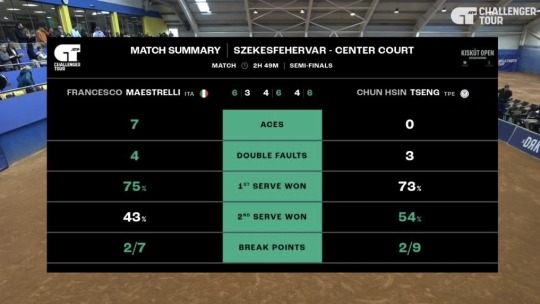
📸 ATP official website
F. Maestrelli had his moments in the first set thanks to his aggression, but it was not sustainable as soon as Jason found his range. Through his groundstrokes, he tried to take advantage out of F. Maestrelli's second serve issues, where he successfully absorbed some pace and shift the flow in his favor, especially considering his point construction under pressure often pressed F. Maestrelli's position further. As a result, despite both players breaking twice throughout the match, Jason still managed to generate 2 more break points than F. Maestrelli.
Interestingly, both players had their own service game strengths. F. Maestrelli had a slight advantage on his first serves winning percentage, winning 75% points from there, 2% more than Jason, which sometimes got him out of trouble. On the other hand, it was statistically confirmed that F. Maestrelli had troubles in navigating the second serves, double-faulting four times while struggled to follow it up, which faded his second serve winning percentage 9% below Jason as the match progressed.
In tomorrow's final, Jason will face Titouan Droguet, who earlier also stunned Franco Agamenone 6-2, 6-2 in a straightforward manner. This could be an interesting battle of contrasts, where their balance would be tested: whether their groundstrokes, or their point construction, or their defense-to-offense mechanisms, or somewhere in between. Should be an exciting companion for the day, taking into account both Szekesfehervar and Hamburg finals will be played simultaneously.
#atp world tour#atp tour#atp challenger#atp challenger tour#tennis updates#match stats#szekesfehervar challenger#kiskút open#francesco maestrelli#chun-hsin tseng#WatchChallengersFolks#ChallengerMatters
0 notes
Text
youtube
0 notes
Text
Come restituì Renzi i 700mila euro
Come restituì Renzi i 700mila euro
(Francesco Grignetti – la Stampa) – È un rapporto che viene da lontano, quello tra Matteo Renzi e Riccardo Maestrelli, l’ imprenditore fiorentino che ha prestato i famosi 700mila euro all’ ex premier. Si può fissare una prima data al maggio 2009. Renzi è il giovane ambizioso presidente della provincia che cerca di dare la scalata al capoluogo e Maestrelli il figlio del più famoso Egiziano, uno…
View On WordPress
0 notes
Video
youtube
Brandon Nakashima vs Francesco Maestrelli | QF Tenerife • Highlights
0 notes
Text
Erano per Almirante, ma piacevano a Berlinguer: ode ai “bad boys” del calcio, la Lazio irriverente di Chinaglia e Maestrelli
“Ogni volta che un bambino prende a calci qualcosa per la strada, lì ricomincia la storia del calcio”, diceva Jorge Luis Borges. Li hanno definiti maneschi e fascisti, eppure hanno scritto una delle pagine più belle del calcio italiano. C’è tutta una letteratura su quella squadra di cui ha parlato nel libro Pistole e palloni, ripubblicato nel 2017 da Liet Edizioni, il giornalista e scrittore Guy Chiappaventi. La Lazio di Tommaso Maestrelli, l’allenatore buono, nel 1972-’73 sfiorò lo scudetto e vinse il campionato di serie A nel 1973-’74. Due anni prima militava in serie B. L’ambiente non aveva accolto favorevolmente quel gentiluomo nato a Pisa, che aveva combattuto in Montenegro, che era stato un giocatore dell’odiatissima Roma e che aveva guidato, fino quel momento, compagini di serie cadetta come la Reggina, il Bari e il Foggia. Poi, all’improvviso, il miracolo Lazio. Era specialmente la squadra di Giorgio Chinaglia e Giuseppe Wilson, che non sopportavano chi parlasse lombardo. Maestrelli aveva diviso lo spogliatoio in due. Di qua i chinagliani, di là Martini, Re Cecconi e “quelli del nord”. Chinaglia, centravanti, era un ragazzone bizzoso, figlio di emigranti che aveva iniziato a giocare in Galles dove gli italiani venivano definiti con disprezzo “i camerieri”. L’altro, Wilson, difensore colto e raffinato, il primo calciatore laureato ancora in attività. Nell’undici di base della Lazio del ’74 militavano: Felice Pulici, Sergio Petrelli, Luigi Martini, Giuseppe Wilson, Giancarlo Oddi, Franco Nanni, Renzo Garlaschelli, Luciano Re Cecconi, Giorgio Chinaglia, Mario Frustalupi e Vincenzo D’Amico. La squadra si dichiarava politicamente dalla parte dell’Msi di Giorgio Almirante, ma Enrico Berlinguer, segretario del Pci, aveva simpatie per i colori bianco-azzurri e non lo nascondeva. “Eravamo convinti che potessimo fare ciò che volevamo, sempre e dappertutto”, ha ammesso il capitano Wilson in una recente intervista che ho pubblicato sulla rivista “Lazialità”. Quei giocatori sparavano alle lampadine degli alberghi lasciando sbigottiti i proprietari, ma anche in mezzo alle gambe dei massaggiatori che si prestavano a fare da cavie. Qualcuno volava con il paracadute. Eppure hanno scritto una delle pagine più belle del calcio italiano di tutti i tempi, tanto da attirare le attenzioni del figlio del Presidente delle Repubblica Giovanni Leone, Giancarlo (oggi dirigente di spicco della Rai), che il giovedì si allenava con quel gruppo di scalmanati. Durante le partitelle infrasettimanali volavano spintoni, schiaffi, calci e qualche fondo di bottiglia. La domenica, però, il mucchio selvaggio era un blocco unito, granitico. Sono morti quasi tutti, qualcuno addirittura per un’incredibile fatalità (a Re Cecconi il 18 gennaio 1977 spararono dentro una gioielleria in circostanze mai chiarite del tutto, nonostante la versione ufficiale fu che avesse inscenato una finta rapina). Giorgio Chinaglia, latitante negli Stati Uniti e imputato in Italia per i reati di riciclaggio di denaro e aggiotaggio nel tentativo di riprendersi la Lazio, se ne è andato il 1° aprile 2012, di domenica durante l’ora delle partite.
*
Ma come fece quella squadra così irregolare a vincere il campionato contro ogni previsione? Annotò Mimmo De Grandis (il padre di Stefano, noto conduttore televisivo di Sky Calcio) in S.S. Lazio (Edi-Grafic 1977): “Nessuno lo pensa, nessuno se ne accorge. La squadra è divisa, c’è un gruppo di maggioranza, uno di minoranza, c’è il gruppo degli indipendenti. Al di sopra di tutti si innalza però la figura di Tommaso Maestrelli che tiene in pugno la situazione e governa la barca con sensibilità e intelligente elasticità”. Il segreto stava nelle capacità umane di questo padre per tutti. Affabile, discreto, in grado di gestire sapientemente i suoi ragazzi. Li capiva, li ascoltava. Li difendeva, li perdonava. Il giornalista Franco Recanatesi ha scritto un volume che lo ricorda affettuosamente: Uno più undici (L’Airone 2006) definendo Tommaso Maestrelli “l’interprete più anomalo e meno integrato di un mondo decisamente venale, discretamente superficiale e un po’ tronfio”. Gianni Brera reputava la Lazio un’eresia calcistica. Giocava un calcio all’olandese, arrembante e dinamitardo. Ma si sa, le storie belle finiscono presto. Nell’inverno del 1975 Maestrelli iniziò a stare male e si accasciò al termine di una trasferta vittoriosa a Bologna. Il perseverare dei sintomi lo costrinse a sottoporsi ad esami clinici. Gli fu diagnosticato un epatocarcinoma al fegato. “Perché mi avete chiamato per farmi vedere un morto?”, disse il famoso chirurgo Paride Stefanini allargando le braccia. Perse quasi quindici chili in due settimane. La squadra dello scudetto, senza il suo allenatore, stava precipitando in serie B. All’inizio della stagione 1975-’76 venne chiamato sulla panchina il bergamasco Giulio Corsini, che entrò subito in conflitto con Chinaglia. L’intransigenza di Corsini cozzava con lo spirito di ragazzi anarchici e ammaestrati solo dalla bontà e della dolcezza di Maestrelli. I giocatori continuavano a pensare al loro secondo padre e passavano ore al suo capezzale. Intanto un immunologo genovese, Saverio Imperato, stava sperimentando sull’allenatore una nuova cura contro il cancro. Si era presentato spontaneamente promettendo la guarigione. I risultati furono stupefacenti. Maestrelli, sul letto di morte, cominciò a reagire bene e gli tornò l’appetito. La cura si chiama sinterapia, ed è un trattamento che agisce in sinergia con le terapie ufficiali utilizzando il vaccino BCG per stimolare le difese immunitarie del corpo a reagire contro le cellule tumorali. L’allenatore buono ordinava il pesce e la carne mentre i ristoranti di Roma si mobilitavano per portargli a casa i piatti più prelibati. L’attrice Lea Padovani, tutti i lunedì, gli faceva recapitare la pasta con i fagioli da lei stessa cucinata.
*
Era il 30 novembre del 1975. Un giorno insignificante, una domenica come un’altra, per gli italiani. La Lazio partì per la trasferta di Ascoli Piceno. Negli spogliatori dello stadio, prima della gara, in uno dei tanti diverbi tra Chinaglia e Corsini, l’attaccante diede un ultimatum all’allenatore: “Se oggi perdiamo, tu te ne vai”. Maestrelli, da casa, si apprestava ad ascoltare “Novantesimo Minuto” seduto sulla poltrona del salotto. Ad Ascoli faceva freddo. In Piazza del Popolo, chiusa dallo splendido abside di San Francesco, il convoglio dei tifosi di casa partiva alla volta dello stadio. Ascoli era per tutti la città di Alfredo Alfredo di Pietro Germi, e Dustin Hoffman poteva sembrare un po’ l’americano che sarebbe diventato di lì a poco Giorgio Chinaglia andando a giocare nei Cosmos stellari di Pelé e Beckenbauer, diventando in un paio di anni l’icona del calcio statunitense che si stava espandendo in tutto il paese. Allo stadio Cino e Lillo del Duca l’Ascoli si batté al massimo delle forze, mentre la Lazio appariva smarrita. Segnarono Gola e Morello. All’ultimo minuto l’arbitro indicò il dischetto del calcio di rigore in favore la squadra romana. Chinaglia realizzò con un tiro laterale a sinistra. Il bomber esultò, irriverente, verso il pubblico ascolano che l’aveva fischiato per novanta minuti. Per i laziali Ascoli non era di certo, quella notte, la città del film I delfini di Citto Maselli, in cui i giovani del posto furono incapaci di rompere un ordine prestabilito, di andarsene dal luogo della nascita, ma proprio nella cittadina marchigiana nacque la suggestione dell’incredibile ritorno. Chinaglia e Wilson telefonarono a Maestrelli abbandonando ogni indugio: “Mister, noi senza di lei siamo un’armata brancalone”. L’allenatore buono fece una scelta d’amore. Emaciato, magro, febbricitante, ritornò in panchina per i suoi ragazzi. Quando mercoledì 3 dicembre 1975 sciolse ogni riserva, a molti tifosi vennero le lacrime agli occhi, mentre altri aspettarono che si accomodasse in panchina, per crederci veramente. Fu accolto da 75.000 spettatori per la partita interna con il Napoli del 7 dicembre. Salvò la squadra dalla retrocessione, ma morì l’anno successivo, il 2 dicembre 1976. Per un destino crudele, nel 1999 e nel 2011, sono venuti meno, per lo stesso male, anche Patrizia e Maurizio, due dei quattro figli.
*
Tommaso, dopo la partita di Ascoli, aveva chiamato la moglie Lina per dirle: “Amore mio, torno ad allenare. Non mi dire di no”. Si era appena lavato il viso e aveva passato il dopobarba sul mento. Si infilò un maglione e si avviò in corridoio dove era posizionato il telefono. Chinaglia e Wilson si abbracciarono come bambini perché erano stati i primi a saperlo, appena rientrati nella capitale e diretti al night club preferito, il “Jackie’O”, meta del jet set italiano di allora. I bad boys avevano finalmente ritrovato il loro maestro. Belli e maledetti, come quella Lazio eccessiva, indomita. Una formazione dove Giorgio Chinaglia si permetteva di sbeffeggiare la Juventus e perfino Gianni Agnelli in persona, l’unico che lo aiutò nella folle impresa di diventare presidente della Lazio nel 1983. Oggi, in un’epoca oberata da costi e fatturati, il calcio degli affetti è svanito. E ci manca, come ci mancano Maestrelli e Chinaglia. Chissà se Giorgio, Long John dalla marca di whisky che beveva, si sentiva solo, in Florida. Dicono che non facesse altro che parlare di Roma, dei tempi belli. Tante volte era tornato e tante volte se ne era andato. Un’avventura continua. Roma è stato sempre orfana di lui, quando non c’era. Ogni settimana lo raggiungeva Giancarlo Oddi al telefono. Parlavano da vecchie glorie, ma l’amore per quella maglia era rimasto immutato. E pensare che qualche giorno prima ci aveva anche giocato, sulla malattia. L’ex compagno di squadra gli aveva detto: “Mica te ne vorrai andare prima di rivederci?”. Lui rispose che stava bene e rise. Aggiunse poche cose con la voce roca, intervallata dalla boccata di una sigaretta appena accesa. A Naples, nella città dove viveva, il clima era ideale. Ci abitano anche Steven Spielberg e Larry Bird su quella linea costiera dal clima temperato. Ma Roma era Roma. I figli di Tommaso Maestrelli hanno voluto che salma del campione fosse tumulata accanto a quella del padre nel cimitero di Prima Porta a Roma (dove ancora oggi giungono mazzi di fiori da tutta Italia). Per una ricongiunzione ideale, come dopo quella lontana partita di Ascoli, che ormai quasi nessuno ricorda più.
Qualunque cosa può essere mitologia. Anche il mito dell’infanzia, del tutto soggettivo, che in questo caso si lega al gioco del calcio, al “basso epico” che Jorge Luis Borges vede come la faccia moderna di un passato altrettanto mitologico, quello dei gladiatori dell’Impero Romano per intenderci, dei lottatori che sublimavano la lotta per la sopravvivenza. Il mito segue il senso della forza fisica, dell’imposizione fiera ed eroica incarnata da Tommaso Maestrelli e Giorgio Chinaglia.
Alessandro Moscè
L'articolo Erano per Almirante, ma piacevano a Berlinguer: ode ai “bad boys” del calcio, la Lazio irriverente di Chinaglia e Maestrelli proviene da Pangea.
from pangea.news https://ift.tt/2L31rt3
0 notes
Text
Serie B, Serie B, Serie B !!!
FINALMENTE IL CTP TORNA DOVE MERITA DI ESSERE .... IN SERIE B !!!
Pochi minuti fa i ragazzi capitanati da Mattia Ceruti si sono imposti con un netto ma comunque tirato 4 a 0 presso il TC Prato.
La splendida cavalcata stagionale ha avuto il suo giusto epilogo con i nostri ragazzi in grande forma e autori di prove di alto livello, sia tecnico sia soprattutto caratteriale.
Non ce ne vogliano i grandissimi e bravissimi primi giocatori schierati oggi da capitan Mattia ... che ricordiamo con nome e risultati ...
MANFRED FELLIN (2.3) b. Maestrelli Francesco (2.5) 63 61
JACOPO BARTOLINI (2.4) b. Bonechi Stefano (2.7) 75 63
REMY BERTOLA (2.5) b. Materi Matteo (2.7) 62 62
... ma bello sottolineare come il punto della vittoria sia arrivato dal giovane e sempre lottatore LEONARDO CASSAGO (2.6) che ha lasciato col fiato sospeso i compagni presenti ed i tanti tifosi collegati real time da casa, imponendosi per 46 75 63 al bravo 3.1 Banti Cosimo.
Che dire ragazzi ... dopo le due settimane di grande tennis con il torneo Open Rossetti (vinto come ricordiamo da Remy Bertola), siete stati perfetti a ritrovare la concentrazione e a non lasciare nulla ai tennisti toscani. Essere favoriti dalle classifiche spesso diventa un boomerang negli incontri a squadre, soprattutto in trasferta. Questo risultato testimonia di una crescita tecnica e mentale di cui i vostri coach Mattia e Mauro sono orgogliosi, insieme a chi scrive e a tutta la dirigenza del CT Parabiago.
Onore e meriti a tutti voi ragazzi, anche e soprattutto a chi non ha giocato oggi ma che durante tutta la stagione ha dato il proprio indispensabile contributo ... per cui (in rigoroso ordine alfabetico ...) ecco i componenti della squadra di Serie ... B del CTP:
ARNONE COMPARE MAURO
BARTOLINI JACOPO
BERTOLA REMY
CARLONE NICOLAS
CASSAGO LEONARDO
CATTANEO ANDREA
CERUTI MATTIA
CRESPI GIACOMO
COZZI LUCA
FELLIN MANFRED
MORELLI RICCARDO
... e un paio di belle foto di gruppo !
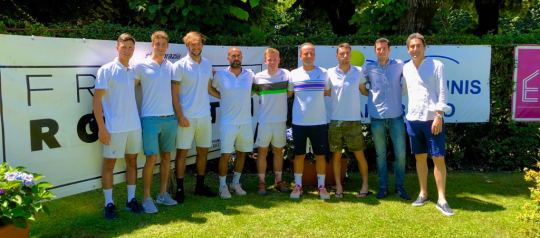
Cassago - Carlone - Bartolini - Arnone - Bertola - Mattia - Fellin con Diego Scalvini (Assessore allo Sport del Comune di Parabiago) e il nostro sponsor/giocatore Luca Rossetti
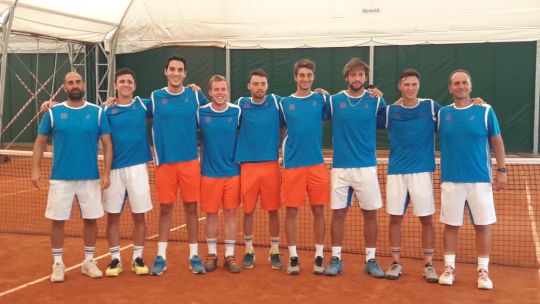
La squadra schierata a Prato: Arnone - Cattaneo - Crespi - Bertola - Fellin - Carlone - Bartolini - Cassago e capitan Mattia !!!
Che la cavalcata del 2018 sia di buon auspicio per un sogno anche nel 2019 !!!
GRAZIE RAGAZZI !!!!
0 notes